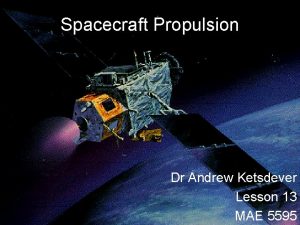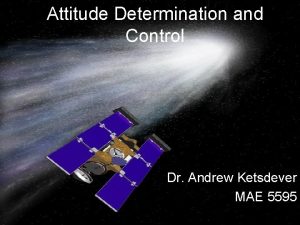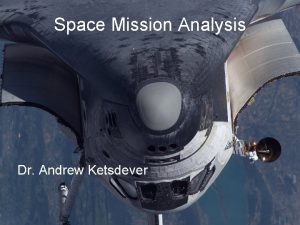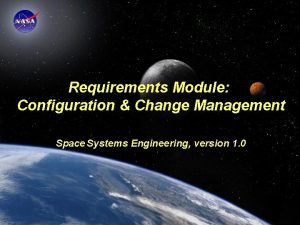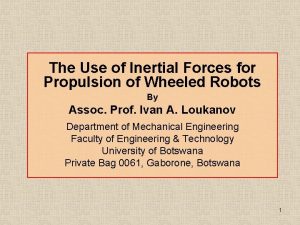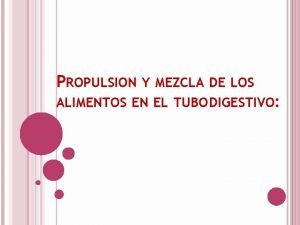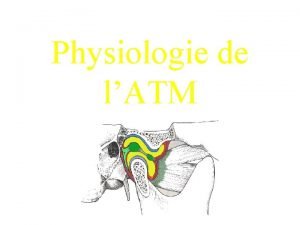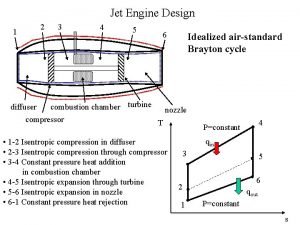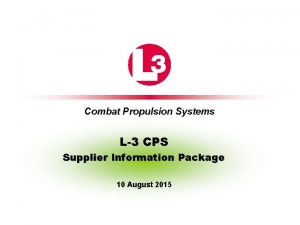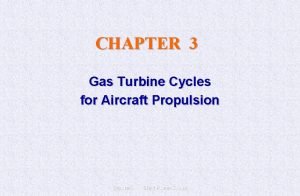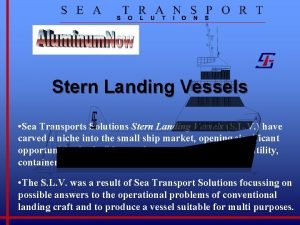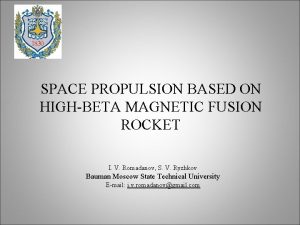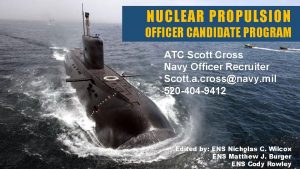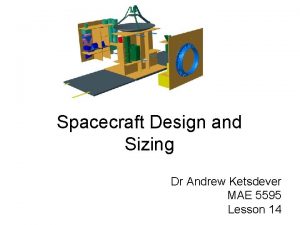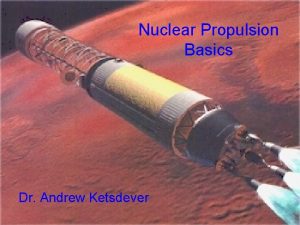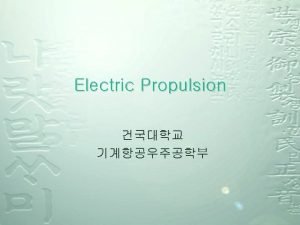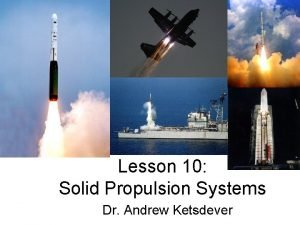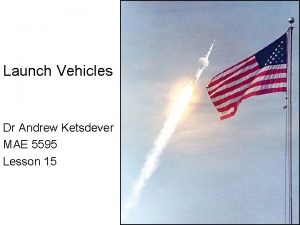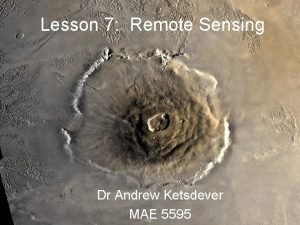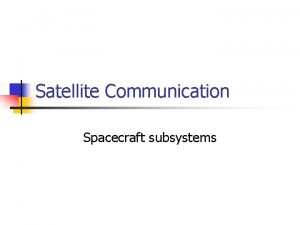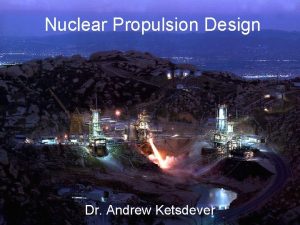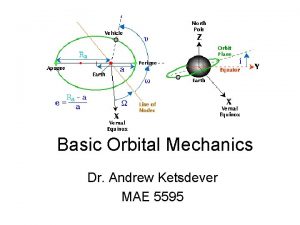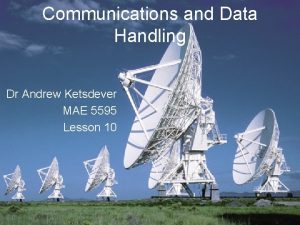Spacecraft Propulsion Dr Andrew Ketsdever Lesson 13 MAE













- Slides: 13

Spacecraft Propulsion Dr Andrew Ketsdever Lesson 13 MAE 5595

Introduction • Purpose of the propulsion subsystem – Transfer spacecraft from launch vehicle parking orbit to spacecraft mission orbit – Maintain and control spacecraft attitude • Types of spacecraft propulsion systems – Chemical • Liquid, Solid or Hybrid – Solar Electric – Nuclear • Thermal or Electric

Typical Propulsion Requirements

Typical Propulsion Requirements Maneuver ΔV, km/s Orbit transfer: LEO to GEO GTO to GEO (1) GTO to GEO (2) LEO to Earth escape LEO to translunar orbit LEO to lunar orbit GTO to lunar orbit LEO to Mars orbit LEO to solar escape 3. 95 (no plane change required) 4. 2 (including plane change of 28 deg) 1. 5 (no plane change required) 1. 8 (incl. plane change of 28 deg. ) 3. 2 3. 1 3. 9 1. 25 -1. 4 5. 7 8. 7 Orbit control: Station-keeping (GEO) 50 -55 m/s per year Orbit control: Drag compensation • alt. : 400 -500 km • alt. : 500 -600 km • alt. : >600 km < 100 m/s per year max. (<25 m/s average) < 25 m/s per year max. (< 5 m/s average) < 7. 5 m/s per year max. Attitude control: 3 -axis control Auxiliary tasks: • Spin-up or despin • Stage or booster separation • Momentum wheel unloading 2 -6 m/s per year 5 -10 m/s per manoeuvre 2 -6 m/s per year

INTELSAT V • Propellant mass of 168. 9 kg required – Transfer orbit (7 kg) • Spin up, reorientation – Drift orbit (29. 9 kg) • Reorientation, spin down – GEO (132 kg) • • NS Station Keeping (106 kg) EW Station Keeping (11. 7 kg) Attitude Maintenance (12. 3 kg) Disposal (2 kg)

INTELSAT V • ORBIT TRANSFER – INTELSAT V satellite has a Thiokol AKM that produces an average thrust of 56 k. N (12, 500 lbf) and burns to depletion in approximately 45 seconds. • STATIONKEEPING AND ATTITUDE CONTROL – Array of four 0. 44 N (0. 1 lbf) thrusters for roll control, – Array of ten 2. 0 N (0. 45 lbf) thrusters for pitch and yaw control and E/W stationkeeping, – Array of two 22. 2 N (5. 0 lbf) thrusters for repositioning and reorientation. – Four 0. 3 N (0. 07 lbf) EHTs are used for N/S stationkeeping. • The nominal mass of the spacecraft at beginning of life (BOL) is 1005 kg and the dry mass at end of life (EOL) is 836 kg. The difference of 169 kg represents the mass of the propellant for a design life of 7 years.

Chemical Propulsion • Chemical reaction produces energy – Liquid • Bipropellant – Two reactants » Fuel and Oxidizer » MMH, UDMH, O 2, HNO 3, N 2 O 4 • Monopropellant – Single reactant » Catalyst » N 2 H 4, H 2 O 2 – Solid • Fuel and oxidizer combined in a solid mixture (grain) – Hybrid • Typically a solid fuel and a liquid or gaseous oxidizer

Solar Electric Propulsion • Several Classifications – Electrothermal • Resistojet • Arcjet – Electrostatic • Ion engine – Electromagnetic • Pulsed Plasma Thruster • Hall Effect Thruster • MPD

Nuclear Propulsion • Fission or Radioactive Isotope Decay • Nuclear Thermal Propulsion (NTP) – Transfers heat produced by nuclear process into propellant gas – Propellant heating increases thrust and specific impulse • Nuclear Electric Propulsion (NEP) – Uses heat produced by nuclear process to produce electric power – Electric power used to ionize and accelerate propellant

Propellant-less Propulsion • Solar Sail – Uses solar pressure to generate thrust – Large, reflective surface area required • Electrodynamic Tether – Uses Earth’s (or other planet’s) magnetic field to generate a force (with an electric current) • Atmospheric Drag – Aerobraking – Re-entry

How a Thermodynamic Rocket Works m = mass flow rate (kg/sec) ve = propellant exhaust velocity (m/sec) pe = pressure at nozzle exit (Pa) pa = ambient pressure (Pa) Ae = area of nozzle exit (m 2) For Ideal Expansion (pe = pa):

Equations • • • Thrust Mass Flow Impulse Specific Impulse Ideal Rocket Equation Propellant Tank Mass

Nozzle Expansion
